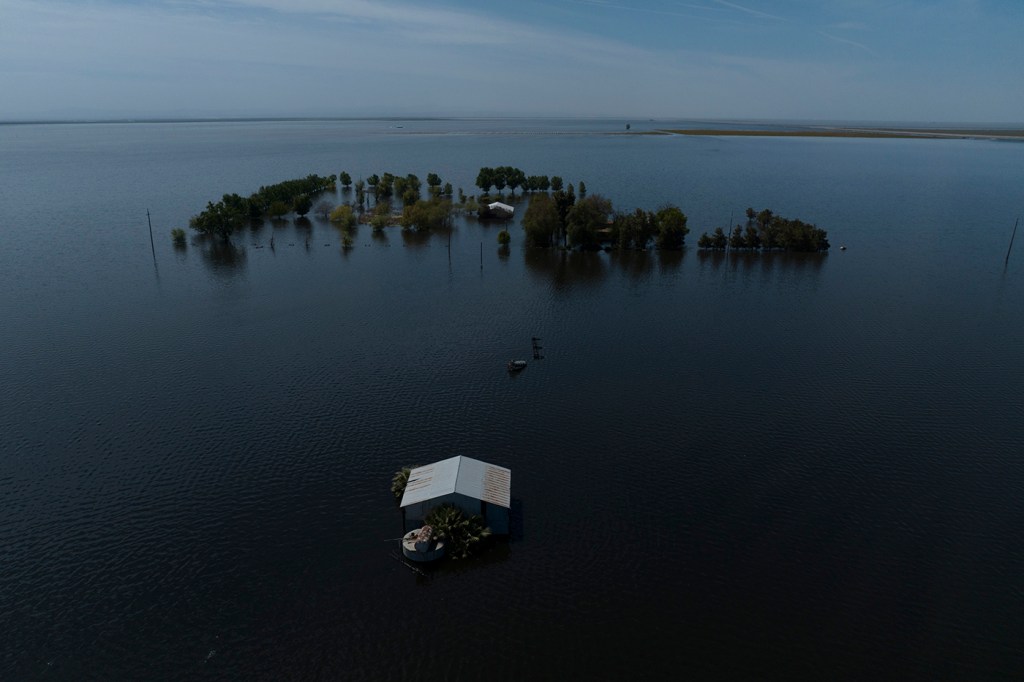The largest body of water west of the Mississippi disappeared 130 years ago — now it’s back
Tulare Lake, called “Pa’ashi” by the indigenous Tachi Yokut tribe, disappeared 130 years ago from California. Now, after a series of severe weather events, the lake has returned, with both positive and harmful effects.

The San Joaquin Valley of California, despite supplying a significant percentage of the country’s food, is nevertheless a dry, arid place. Fresno, at the heart of the valley, receives just over 10 inches of rain a year on average, according to the National Weather Service, and sometimes as little as 3.
And yet, until the late 19th century, the San Joaquin Valley held a lake over 100 miles long and over 30 miles wide.
Tulare Lake “was the largest body of fresh water west of the Mississippi River. It’s really difficult to imagine that now,” says Vivian Underhill, formerly a postdoctoral research fellow at Northeastern University with the Social Science and Environmental Health Research Institute.
In research conducted while at Northeastern, Underhill describes the lake’s recent, surprising return as a result of 2023’s atmospheric rivers over California, and the effects the lake’s return has had on indigenous communities, wildlife and agricultural workers in the San Joaquin Valley.

Once, Underhill says, there was so much water that a steamship could carry “agricultural supplies from the Bakersfield area up to Fresno and then up to San Francisco” — a distance of nearly 300 miles.
The “ancestral lakes” and connecting waterways that made such a route possible have all but disappeared thanks to manmade irrigation, Underhill says.
Called “Pa’ashi” by the indigenous Tachi Yokut tribe, Tulare Lake was fed primarily by snowmelt out of the Sierra Nevada mountains, Underhill says, as opposed to rainfall. And because “there’s no natural outlet within the valley,” the water collects to form a lake.
To many traveling through the San Joaquin Valley today, it’s hard to imagine such a large body of water co-existing alongside such an arid landscape, Underhill says. But in the 1800s, “Fresno was a lakeside town.”
One unnamed prospector, she continues, reported that “there was driftwood piled in the trees of downtown Fresno” because of recent flooding.
Where did the water go?
The lake first began disappearing in the late 1850s and early 1860s, Underhill says, propelled by “the state of California’s desire to take public land and put it into private ownership.”
However, Underhill continues, “when we say ‘public land,’ that is historically indigenous land that the state of California blanket-proclaimed as ‘public.’”
“They really wanted to get [land] into private hands so that indigenous land claims — that were ongoing at that time — would be rendered moot by the time they went through the courts.”
This process was called “reclamation” and often entailed “either draining inundated land or irrigating desert land to create arable farmland. Reclamation really was a process across the entire U.S. west,” Underhill says.
If “people could drain that land,” she says, they would “be granted ownership of parts of that land. So there was a big incentive for white settlers to start doing that work.”
“It was a deeply settler colonial project” that “proceeded in fits and starts.”
The first time the lake fully disappeared was around 1890, when its “water essentially was [used to] irrigate all of the arid lands around that area.”
“Now the valley is crisscrossed by hundreds of irrigation canals, all of which were originally built to take that lake water and put it onto irrigated fields,” she says.
But in 2023, Tulare Lake — Pa’ashi — came back. “California just got inundated with snow in the winter and then rain in the spring,” Underhill says. “If you have a rain and snow event, the snow melts really fast.”
And all that snow and rain in the Sierra still runs into the depression where Tulare Lake once sat.
A complicated homecoming
Underhill’s quick to note that this isn’t the lake’s only return since the 1800s, however. “It happened in the ’80s, it happened once in the ’60s, a couple of times in the ’30s.”
The repercussions for the lake’s return are complex and layered, Underhill says, with sometimes oppositional effects between wildlife and the humans who live in the valley.
Before the lake’s disappearance into irrigation canals and watering spigots, “People talk about there being so many wetland birds,” Underhill says, “that if you startled them, when they lifted off it was like a giant clap that resounded across the landscape.”
Now, after less than a year back, “birds of all kinds — pelicans, hawks, waterbirds” are returning. And Underhill notes that “the Tachi also say that they’ve seen burrowing owls nesting around the shore,” a species described as “vulnerable or imperiled” by the U.S. Fish and Wildlife Service.
Tulare Lake was once part of the Pacific Flyway, Underhill says — it was an important stopover area for migratory birds. “The loss of that habitat has been a major issue in bird conservation and bird diversity.”
“Something that continues to amaze me is — [the birds] know how to find the lake again. It’s like they’re always looking for it.”
In addition to species returning — including fish and amphibians likely brought down from the Sierras by rainfall and flooding — winds off the lake can cool temperatures by as much as 10 or 20 degrees, Underhill says. A real benefit when San Joaquin Valley summers often spike well above 100 degrees Fahrenheit.
Differential effects
When it comes to human occupancy in the Central Valley, Underhill says that there are three distinct groups that have been affected by the lake’s return.
The first is the Tachi Yokuts, for whom “the return of the lake has been just an incredibly powerful and spiritual experience. They’ve been holding ceremonies on the side of the lake,” Underhill says. “They’ve been able to practice their traditional hunting and fishing practices again.”
The other two groups that Underhill says have been most affected are those involved in agricultural production: the farmworkers on the one hand and the growers on the other — those who own the land and employ the workers.
The growers, “over the last five decades or so, have built a complicated system of flood prevention,” Underhill says. In the latest flooding, these measures “protected some of their farmland, which was essentially the lowest elevation part of the historic lake.”
But by cordoning off this low-lying farmland with canals and weirs, it was the surrounding communities of workers that have now been flooded by Tulare Lake.
Many of these farmworkers “don’t speak English or are procedurally very distant from the state,” Underhill says. Unfortunately, they are also the ones who “experience the most personal, place-based impact in terms of having their housing flooded [or] losing their homes entirely.”
Looking out for the lake
“Most of the news coverage about this time talked about it as catastrophic flooding,” Underhill says. “And I don’t want to disregard the personal and property losses that people experienced, but what was not talked about so much is that it wasn’t only an experience of loss, it was also an experience of resurgence.”
She points to the return of native wildlife as one example, and to the Tachi’s ability to practice their traditions on the water.
Efforts are already underway to drain the lake once more, and Underhill expects it to remain in some form for about two more years — although new atmospheric river events over California this year could complicate that prediction.
“Under climate change,” Underhill says, “floods of this magnitude or higher will happen with increasing frequency.”
“At a certain point, I think it would behoove the state of California to realize that Tulare Lake wants to remain. And in fact, there’s a lot of economic benefit that could be gained from letting it remain.”
Of what happens next, Underhill says that “this landscape has always been one of lakes and wetlands, and our current irrigated agriculture is just a century-long blip in this larger geologic history.”
“This was not actually a flood. This is a lake returning.”







